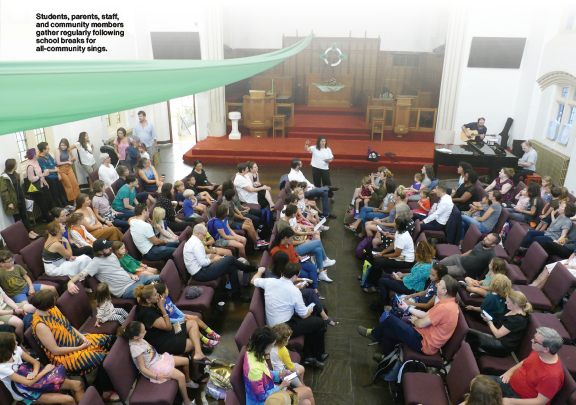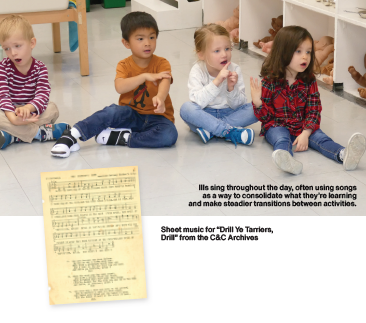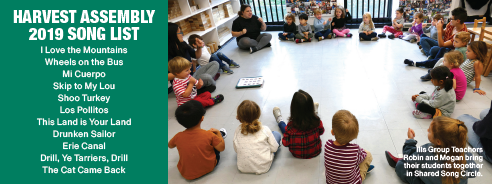In Tune: The Power of Singalong at C&C
4/27/2020

From Works In Progress, the C&C Magazine, Issue III
It was only the fourth day of school for the full IIs–XIIIs community. Children dreamt of a summer well-spent; parents continued to adapt to the routines of the school year. Teachers, too, eased their students (and themselves) into the curriculum. For all of its potential, the first week of school can also be one of the most s
It was only the fourth day of school for the full IIs–XIIIs community. Children dreamt of a summer well-spent; parents continued to adapt to the routines of the school year. Teachers, too, eased their students (and themselves) into the curriculum. For all of its potential, the first week of school can also be one of the most stressful times of year, as the community comes together and begins to search for its rhythm.
But on the morning of September 12, 2019, all of the nervousness and start-of-year jitters subsided as parents and children, teachers and staff, came together at the sanctuary of The Church of the Village (201) to sing. As the community lifted their voices in song, the rhythm took hold, and the year didn’t feel so new anymore.
“When our community is focused on singing and listening,” said C&C Principal Scott Moran, “you’re able to strip away all of the thoughts that you carry into spaces from other parts of your life and just settle into the simplicity of the music and the emotion of connecting and being together. Everyone leaves in a calmer state, engaging with the people around them. One of the most interesting parts doesn’t even happen in the sanctuary—the walk back from 201 carries a warmth of feeling into the School.”
That end result—a connected community—is exactly why Scott and Millie Cartagena, Director of Community Life, Equity, and Inclusion, began the “all-community sings” last year. Since these expanded singalongs began, Millie has observed a more interconnected community emerge.
Even the youngest C&C students are deeply engaged in this community experience. As Millie recalled, “Last year, there was a three-year-old who was singing every single word of the songs. I went up to the mom and whispered, ‘Wow, I can’t believe he knows every word.’ She said, ‘Well, he had us practicing at home!’”
Singing as a community creates a space where new relationships are fostered and existing relationships are strengthened. “The all-community sings are intended to gather and unify our whole community,” said Millie. “The feedback I receive from families, students, and staff about these singalongs is full of joy and warmth.”
Singalongs, of course, have long been a core experience at our School. “Singing is what makes C&C special and unique,” a XIII shared. “Singing is nurturing and welcoming, and it connects us all—from the XIIIs to the IIs.” From the School’s early days, Groups have sung together in different contexts. Younger Groups often sing to help them understand what they’re learning, solidify their bond as a Group, and make steadier transitions. Older Groups use music to bring their Social Studies alive, in part by singing in their Plays. Singing has historically brought the School together during assemblies, strengthening C&C’s sense of community in the process.
One of C&C’s first Music teachers, Margaret “Braddy” Bradford Boni (1928–1954), understood the importance of singalongs. She curated the C&C song list during her tenure and also edited many noted music books, including the well-known Fireside Book of Folk Songs. Pete Seeger, a folk singer renowned for his ability to unify people through music, taught at C&C in 1949 and 1950 and brought his community-building spirit to the students through song. The Centennial celebrations of 2013–2014 drew from these traditions and featured a memorable alumni singalong. Again last year, alumni visiting for their reunion reconnected to the School and to each other through song. This important role of Music in the C&C curriculum and community culture is one of many threads that connects our current students to our alumni—not only through the act of singing, but also through the shared songs that have been part of the C&C songbook since Braddy’s time.
Other deep connections are made through music at C&C. As Music Teacher Roslyn Willis explains, “Singing has the power to transform the students—those who are participating and those who are listening—by creating connections to other cultures.” Music Coordinator Maja Goceva has also worked to spearhead a number of new initiatives that bring students together in song.

She recently began “cultural shares,” in which students are asked to share music from their home cultures. In addition to these new Music-led initiatives and all-community sings, there are a number of new singalongs that happen throughout the year—from a combination of Groups to the entire Lower School.
“Teachers have been eager to find more ways to sing together,” said Maja. “Lower School teachers have been asking to sing together as a community—not only the entire Lower School, but combining IIIs, IVs, or Vs. I also pair up the IVs and XIIs as part of their greater relationship, the Xs with the Vs, and similar combinations. ‘The more we sing, the better!’ That’s what the community says.”
In the classrooms, IIIs Group Teachers Robin Sage and Megan Lau created Shared Song Circle a few years ago as a way to bring together both morning IIIs Groups, something now practiced by the IVs and Vs Groups as well. The Shared Song Circles have been a success in many ways. “IIIs often mention their friends from [last year in] the IIs, who are now in the other IIIs Group,” said Megan, “and Shared Song Circle is a way to gather together in a joyful community ritual. We alternate between the IIIsM visiting the IIIsR classroom and the IIIsR visiting the IIIsM classroom. The children notice similarities and differences between the classroom environments and get a wider view of the School and their place within it.”

As is always the case at C&C, things happen organically—and in ways not always imagined by teachers. Maja recalled teaching the song “One Day”—a song of peace and hope by reggae singer Matisyahu—to the XIIs in Chorus, and then hearing it being sung by the XIIs to their IVs as they transitioned from the end of the school day down to their parents, just as they see the teachers do.
“I get goosebumps when I think about it,” said Maja, “because I was not expecting that. Those are the things that I love about this school, things that happen spontaneously.”
It’s clear that the tradition of singing together remains relevant and will continue to expand in new ways. As IVsL Group Teacher Liana Stampur pointed out, connecting to one’s community through song has effects far beyond C&C: “Young children who make music together—and see their trusted grown-ups and older peers making music together—participate in an especially joyful way. And it is these experiences within the C&C classrooms and greater communities (amongst many others) that guide our children into becoming participants and change makers in their world.”

